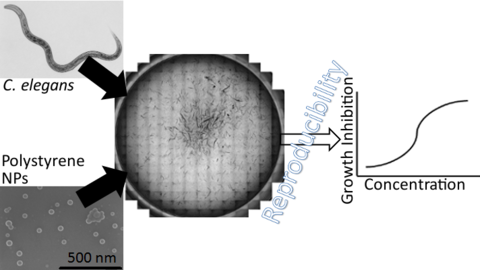NIST Researchers Use a Standardized Caenorhabditis elegans Toxicity Test to Assess Nanomaterial Toxicity

NIST researchers assessed a standard C. elegans toxicity assay to determine if test modifications were needed for nanomaterials. They found that commonly used methods to maintain particle stability impact nematode growth and, therefore, alter assay results.
Toxicity assays are an important component in identifying potential health or environmental hazards associated with chemicals. The development of robust, standardized toxicity assays to understand the potential risks of chemicals in water is critical to making scientifically informed decisions pertaining to chemical management and usage. However, new classes of chemicals, such as nanomaterials (NMs), behave differently from their larger counterparts and dissolved organic and inorganic chemicals, and thus pose challenges for traditional toxicity assays.
Researchers from NIST’s Cell Systems Science Group have tested the feasibility of standardized Caenorhabditis elegans (C. elegans) toxicity assay (ISO 10872) for assessing the toxicity of nanomaterials (NMs) suspended in water. C. elegans is a nematode, which are possibly the most abundant multicellular organisms on the planet. Because of this ubiquity, nematodes are useful in toxicity assays that evaluate the potential effects of pollutants on the environment.
The NIST group conducted a cause-and-effect analysis of the C. elegans assay to identify protocol steps that were expected to contribute the most to the variability of the assay results. This information was used to design and conduct a sensitivity analysis, in which certain parameters were altered, especially those that might be modified for NM testing, to determine how they impacted the assay results. Complete population sampling of the nematode cultures under experimental treatment was achieved with state of the art automated large-field-of-view microscopy imaging. They found that altering the quantity of food (Escherichia coli) provided to the nematodes during the assay drastically changed results. Both the chemical control compound and a positively charged polystyrene nanoparticle (PSNP) were more toxic with lower food concentrations. Additionally, they found that shaking the plates during the assay, which could help to keep insoluble NMs suspended, inhibited growth and reproduction of the nematodes, thus impacting assay results.
Overall, these results highlight the need to assess the robustness of standardized aquatic toxicity assays for use with NMs and to understand the potential interactions that may lead to unforeseen problems in these tests. These findings are the first published results from the new whole organism metrology program in NIST’s Cell Systems Science Group.
Citation: Hanna, S. K.; Cooksey, G. A.; Dong, S.; Nelson, B. C.; Mao, L.; Elliott, J. T.; Petersen, E. J., Feasibility of using a standardized Caenorhabditis elegans toxicity test to assess nanomaterial toxicity. Environmental Science: Nano 2016.

